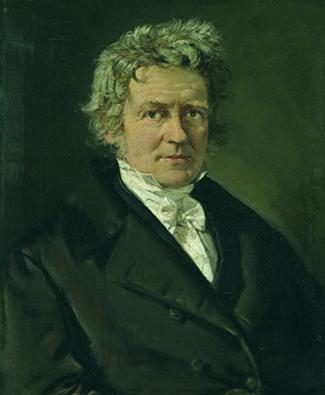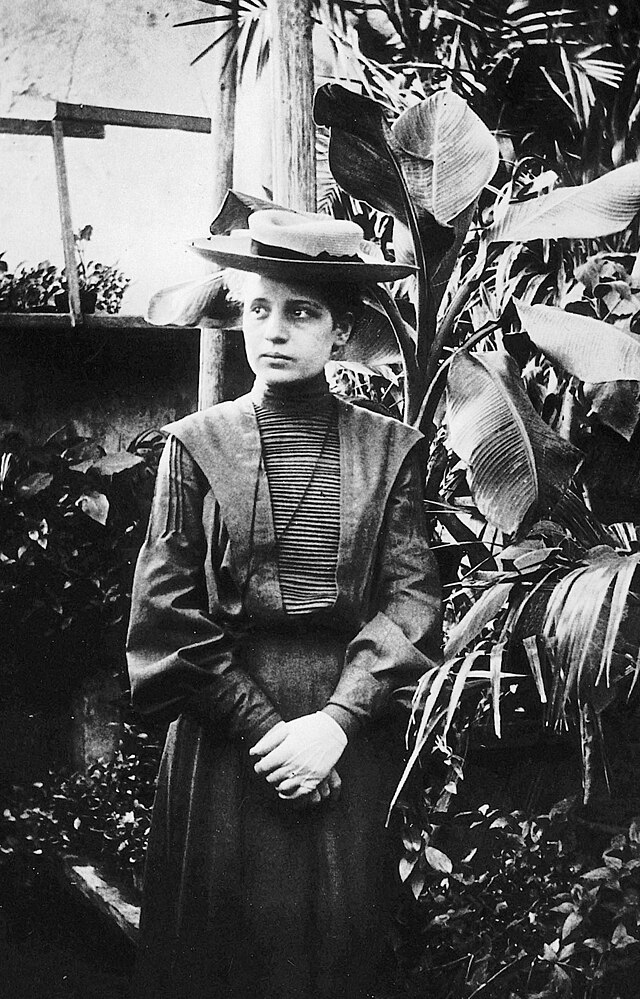 |
| Friedrich Bessel (1784-1846) from Wikimedia Commons |
Bessel was the first to measure the distance of a star by parallax. This is the same phenomenon that you can see if you hold you finger up relative to something in the background and watch the position of your finger change as you look at it with each eye. If you know the distance between your eyes and the angle of the shift, you can calculate the distance of the object.The only catch is that as the object gets farther away, the angle of the shift gets smaller and smaller, but scientists hoped that a shift could be observed as the Earth moves around the sun. Bessel was particularly interested because he considered his duty as an astronomer to explain why the celestial bodies moved as they did.
Tycho Brahe tried in the late 1500s, but was not able to observe parallax. Robert Hooke tried again in the 1600s and claimed to have measured the distance to Gamma Draconis, but no one believed him. He was also wrong: he calculated that it was only 0.1 light years away, when it is actually around 154. James Bradley also tried to measure this distance, but was also unable to, although as a result of his measurements he discovered the aberration of starlight--that you need to account for the movement of the earth and the speed of light in a telescope. William Herschel (who later discovered Uranus) also set about measuring stellar parallax, and tried to find a combination of a close and far star so that he could measure the slight changes in position. Instead, he discovered actual pairs of stars, which are no good since they are about the same distance.
Bessel, as the director of the new observatory in Konigsberg in Prussia, had the use of a telescope made by Joseph Fraunhofer, a maker of telescopes with a precision never seen before. Such an instrument was also in the possession of Struve, astronomer at the Dorpat Observatory in Estonia, and he and Bessel began a race. Struve published a value of the paralax of Vega, but with only 16 measurements. Bessel had been interested in the double star 61 Cygni for many years, having published a paper in 1812 on the subject, and proposed that by observing how they moved in relation to each other, the total mass of the two could be determined. Since it is one of the fastest moving stars in the sky, it was assumed to be one of the closest, and it was observable from his observatory for most of the year. Bessel presented his calculations in 1838, giving a distance of 10.3 light years, which is not too far from the current value of 11.4. Because of his careful measurements, the scientific community, including Struve, accepted his accomplishment as the first.
Bessel's careful measurements of the stars enabled him to make a new discovery as well. He observed that Sirius and Procyon, both bright stars, moved oddly, as though something was influencing them, and corroborated this with historic data as well. He posited that there must be other stars that had not been observed, and indeed, the companion star of Sirius was discovered in 1862 and was recognized as the double star that Bessel had predicted, while Procyon B was not discovered until 1896.
It was also his desire for precise astronomy that led to the Bessel functions, which are solutions to a particular differential equation. Special cases of the functions had been studied before by several Bernoullis, Euler, and Lagrange, among others, but Bessel is considered to have been the person to systematize the equations, and as such, they have been named after him. They appear often in cases involving circles and cylinders, and as such, Bessel found them useful in his studies of the stars, though exactly how I do not know. If it were not for this, people might have never heard his name, but I wonder which accomplishments he would most want to be known for? (And hopefully whatever it was isn't one of the ones that I left out of this short summary.)
Selected Works by Bessel
- "Über den Doppelsterne Nro. 61 Cygni", Monatliche Correspondenz 1812, 26, 148-63.
- "On the parallax of 61 Cygni", Monthly Notices of the Royal Astronomical Society 1838, 4, 152-161. The beginning is worth a read, as he discusses some of the difficulties that he encountered both with the measurements and the calculations associated with them.
- "Bestimmung der Entfernung des 61sten Sterns des Schwans", Astronomische Nachrichten 1839, 16, 65-96. doi: 10.1002/asna.18390160502. German paper on the same topic.
- "On the variations of the proper motions of Procyon and Sirius" Monthly Notices of the Royal Astronomical Society 1844, 6, 136-141. doi: 10.1093/mnras/6.11.136a. This is also a very readable article. Of particular note is the last paragraph, where he deals with the issue of positing the existence of something that can't (or hasn't) been seen.
- "Ueber Veränderlichkeit der eigenen Bewegungen der Fixsterne", Astronomische Nachrichten 1845, 22 (10), 145-160. doi: 10.1002/asna.18450221002. Again, a German article on the same topic.
References
- James Bradley, "A Letter from the Reverend Mr. James Bradley Savilian Professor of Astronomy at Oxford, and F. R. S. to Dr. Edmond Halley Astronom. Reg. &c. Giving an Account of New Discovered Motion of the Fix'd Stars", Philosophical Transactions 1727, 35, 637-661. doi: 10.1098/rstl.1727.0064. Bradley's paper on the aberration of starlight, unfortunately relegated to the references because it is not by Bessel.
- Walter Fricke, "Friedrich Wilhelm Bessel (1784-1846)", Astrophysics and Space Science, 1985, 110 (1), 11-19. doi: 10.1007/BF00660603
- Alan W. Hirshfeld, "The Race to Measure the Cosmos", Sky & Telescope Nov. 2001, p.38. A fuller and very useful description of the various attempts to measure stellar parallax.
- Jay B. Holberg, "LeVerrier and the Discovery of Sirius B: there was more to the discovery of Sirius's white-dwarf companion, now becoming visible again, than is usually told", Sky & Telescope Feb. 2008, p.30.
- Alister Ling and Martin Ratcliffe, "The deep sky: several glittering jewels dot the expansive Milky Way in Cygnus the Swan, but the most intriguing spectacle may be the tattered remnant of a star that blew itself apart", Astronomy Aug. 2003, p.65.
- Alister Ling and Martin Ratcliffe, "The deep sky: comet Encke swoops south and west along the spine of the Milky Way this month, highlighting a number of interesting and beautiful deep-sky objects", Astronomy Nov. 2003, p.61.
- Raymond Shubinski, "How the equatorial mount changed astronomy: an innovative design that allowed telescopes to track the sky made it the star of the 19th century--and today", Astronomy Feb. 2011, 58.
- Todd K. Timberlake, "Seeing Earth's Orbit in the Stars: Parallax and Aberration", The Physics Teacher 2013, 51, 478-481. doi: 10.1119/1.4824942. A good description of the concepts of parallax and aberration with pictures, diagrams, and Hooke and Bradley's data on Gamma Draconis.
- G. N. Watson, A Treatise on the Theory of Bessel Functions (Cambridge: Cambridge University Press, 1996). First published 1922, gives a history of studies of Bessel functions at the beginning.
- Mari Williams, "Beyond the Planets: Early Nineteenth-Century Studies of Double Stars", The British Journal for the History of Science 1984, 17 (3), 295-309.

